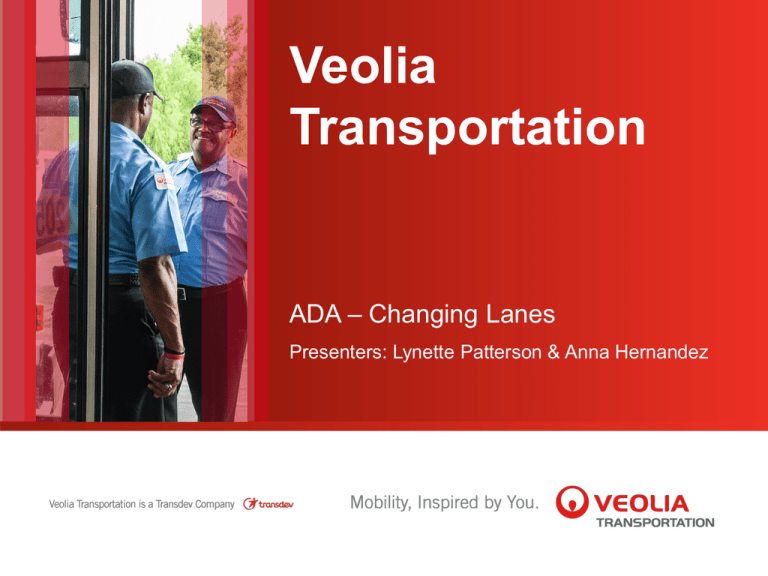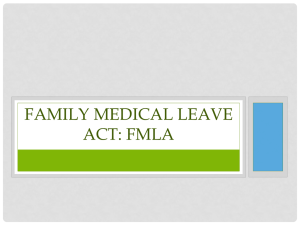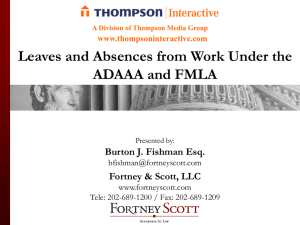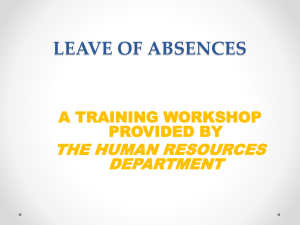Lynette Patterson & Anna Hernandez
advertisement

Veolia Transportation ADA – Changing Lanes Presenters: Lynette Patterson & Anna Hernandez Overview of Veolia Transportation Our Vision Better Mobility Means Better Lives Transdev – Worldwide Our Parent Company Leading private sector operator in 21 countries on 5 continents 48,000 Vehicles and over 95,000 Employees A leader widely recognized for its expertise and long-term client relationships Provides broad multi-modal experience, a personalized and customer-centric approach, and a mastery of digital technologies Who Owns Transdev? 50% Veolia Environnement: A leading global environmental company April 9, 2015 50% Caisse des Depots: A highly respected French financial institution, a long term investor in projects for the public interest 3 Veolia Transportation U.S. and Canada Operate 200 contracts in 130 locations Largest contracted bus operations in the U.S. – Nassau County (Long Island), Phoenix Largest contracted U.S. commuter rail operations – Boston, others in Miami & San Diego Plus other Fixed, Paratransit and On Demand services in: Los Angeles, Denver, Toronto, Montreal, Baltimore, Dallas, Washington, DC, New Orleans Local teams committed to their clients and communities Supported by expertise from corporate and regional teams April 9, 2015 4 North American Operations 17,000 Employees April 9, 2015 5 Delivering Both Quality & Efficiency to Clients Proprietary Technology Delivers Superior Performance Safety First. Service Always. Our Values -- We CARE April 9, 2015 6 CHANGING LANES ADA, CA Leave Laws, FMLA and Worker’s Compensation Intent Of The Presentation Inform Transit Professionals on the legal consequences surrounding California Leave Laws, Federal Family Medical Leave Act (“FMLA”) and the Americans With Disabilities Act (“ADA”) The important role of Human Resources and the Professional Manager managing Leaves and ADA related issues and their understanding of laws, policies and practices to ensure compliance. Understand the basic interplay between CFRA/FMLA/ADA/Worker’s Compensation and Disability. Remember Know your company’s/agency’s policy You may have rules that are more employee friendly than the concepts we discuss today. They SHOULD NOT, however, be less favorable to the employee. If they are, you are likely violating part of the FMLA/CFRA or other laws. The information being presented is not a legal advice. Please consult with your own legal counsel when making employment related decisions. Family Medical Leave Act California Family Rights Act Worker’s Compensation 1 April 9, 2015 Family Medical Leave Act 10 FMLA – Covered Employers The FMLA only applies to employers that meet certain criteria. A covered employer is a: Private-sector employer, with 50 or more employees in 20 or more workweeks in the current or preceding calendar year, including a joint employer or successor in interest to a covered employer; Public agency, including a local, state, or Federal government agency, regardless of the number of employees it employs; or Public or private elementary or secondary school, regardless of the number of employees it employs. April 9, 2015 11 FMLA - Eligibility Only eligible employees are entitled to take FMLA leave. An eligible employee is one who: Works for a covered employer; Has worked for the employer for at least 12 months; Has at least 1,250 hours of service for the employer during the 12 month period immediately preceding the leave*; and Works at a location where the employer has at least 50 employees within 75 miles. April 9, 2015 12 FMLA – Leave Entitlement Eligible employees may take up to 12 workweeks of leave in a 12-month period for one or more of the following reasons: The birth of a son or daughter or placement of a son or daughter with the employee for adoption or foster care; To care for a spouse, son, daughter, or parent who has a serious health condition; For a serious health condition that makes the employee unable to perform the essential functions of his or her job; or For any qualifying exigency arising out of the fact that a spouse, son, daughter, or parent is a military member on covered active duty or call to covered active duty status. An eligible employee may also take up to 26 workweeks of leave during a "single 12-month period" to care for a covered servicemember with a serious injury or illness, when the employee is the spouse, son, daughter, parent, or next of kin of the servicemember. The "single 12-month period" for military caregiver leave is different from the 12-month period used for other FMLA leave reasons. April 9, 2015 13 FMLA – Notice by Employee Employees must comply with their employer’s usual and customary requirements for requesting leave and provide enough information for their employer to reasonably determine whether the FMLA may apply to the leave request. Employees generally must request leave 30 days in advance when the need for leave is foreseeable. When the need for leave is foreseeable less than 30 days in advance or is unforeseeable, employees must provide notice as soon as possible and practicable under the circumstances. When an employee seeks leave for a FMLA-qualifying reason for the first time, the employee need not expressly assert FMLA rights or even mention the FMLA. If an employee later requests additional leave for the same qualifying condition, the employee must specifically reference either the qualifying reason for leave or the need for FMLA leave. See Fact Sheet 28E: Employee Notice Requirements under the FMLA . April 9, 2015 14 FMLA – Notice by Employer Covered employers must: Post a notice explaining rights and responsibilities under the FMLA (and may be subject to a civil money penalty of up to $110 for willful failure to post); Include information about the FMLA in their employee handbooks or provide information to new employees upon hire; When an employee requests FMLA leave or the employer acquires knowledge that leave may be for a FMLA-qualifying reason, provide the employee with notice concerning his or her eligibility for FMLA leave and his or her rights and responsibilities under the FMLA; and Notify employees whether leave is designated as FMLA leave and the amount of leave that will be deducted from the employee’s FMLA entitlement. April 9, 2015 15 FMLA - Certification When an employee requests FMLA leave due to his or her own serious health condition or a covered family member’s serious health condition, the employer may require certification in support of the leave from a health care provider. An employer may also require second or third medical opinions (at the employer’s expense) and periodic recertification of a serious health condition. See Fact Sheet 28G: Certification of a Serious Health Condition under the FMLA. For information on certification requirements for military family leave, See Fact Sheet 28M(c): Qualifying Exigency Leave under the FMLA; Fact Sheet 28M(a): Military Caregiver Leave for a Current Servicemember under the FMLA; and Fact Sheet 28M(b): Military Caregiver Leave for a Veteran under the FMLA. April 9, 2015 16 FMLA – Job Restoration & Health Benefits Upon return from FMLA leave, an employee must be restored to his or her original job or to an equivalent job with equivalent pay, benefits, and other terms and conditions of employment. An employee’s use of FMLA leave cannot be counted against the employee under a “no-fault” attendance policy. Employers are also required to continue group health insurance coverage for an employee on FMLA leave under the same terms and conditions as if the employee had not taken leave. April 9, 2015 17 FMLA - Fact Sheet http://www.dol.gov/whd/regs/compliance/whdfs28.pdf April 9, 2015 18 2 April 9, 2015 California Family Rights Act 19 CFRA The California Family Rights Act (CFRA) (Gov. Code, § 12945.2) was established to ensure secure leave rights for the following: Birth of a child for purposes of bonding Placement of a child in the employee's family for adoption or foster care For the serious health condition of the employee's child, parent or spouse For the employee's own serious health condition In most cases, CFRA will run concurrent with FMLA Employers covered under CFRA Employers subject to CFRA are those who do business in California and employ 50 or more part-time or full-time employees, including non-profit religious organizations. Covered employers also include the State of California and any of its political and civil subdivisions, and cities and counties, regardless of the number of employees. Requirements employee must satisfy to be eligible to take a CFRA leave. To be eligible for CFRA leave, an employee must be either a full-time or part-time employee working in California, have more than 12 months (52 weeks) of service with the employer, have worked at least 1,250 hours in the 12-month period before the date the leave begins, and work at a location in which the employer has at least 50 employees within 75 miles radius of the employee's work site. April 9, 2015 20 CFRA Reinstatement An employer must reinstate the employee at the end of his/her CFRA leave Notification An employee must give advance notice if he/she wants to take a CFRA leave An employer must inform employees of notice requirements Benefits An employer must continue health care coverage for employees during their CFRA leave An employer must continue other benefits during an employee's CFRA leave More information on CFRA: http://www.dfeh.ca.gov/Publications_CFRADefined.htm April 9, 2015 21 CFRA – Notice B April 9, 2015 22 3 April 9, 2015 Worker’s Compensation 23 Worker’s Compensation Employees are entitled to receive prompt, effective medical treatment for onthe-job injuries or illnesses no matter who is at fault and, in return, are prevented from suing employers over those injuries. California employers are required by law to have workers' compensation insurance, even if they have only one employee. Workers' comp insurance provides six basic benefits: Medical care Temporary disability benefits & Permanent disability benefits Supplemental job displacement benefits or vocational rehabilitation and death benefits April 9, 2015 24 Worker’s Compensation - Notification Time of Hire Pamphlet This pamphlet, or a similar one that has been approved by the Administrative Director, must be given to all newly hired employees in the State of California. http://www.dir.ca.gov/DWC/DWCPa mphlets/TimeOfHirePamphlet.pdf April 9, 2015 25 4 April 9, 2015 California Protected Leaves of Absence 26 CA Leaves of Absence Leave California Family Rights Act Pregnancy Disability Leave Paid Family Leave Organ Donor & Bone Marrow Donor Crime Victims Leave Domestic Violence, Sexual Assault, Victims of Stalking Jury or Witness Duty Leave School Activities Leave School Appearance Volunteer Civil Service Leave Voting Leave Eligibility Time Alloted Paid 1 yr and 1250 hours 12 weeks No Upon Hire 17 & 1/3 weeks No Many factors (determined by ST) Up to 6 weeks Yes Donate Organ or Bone Marrow 30 days Yes Judicial Proceedings Varies No Restraining order, medical treatment Varies/Reasonable Accomodations No Jury/Witness Varies No School activities 40 hours per year No Discipline Firefighters or other emergency personnel Varies No 14 days per year No All - posting required 2 hours Yes 5 April 9, 2015 American’s with Disabilities Act 28 What is the AMERICANS WITH DISABILITIES ACT? The ADA prohibits discrimination on the basis of disability in employment, State and local government, public accommodations, commercial facilities, transportation, and telecommunications. Who is protected? To be protected by the ADA, one must have a disability or have a relationship or association with an individual with a disability. An individual with a disability is defined by the ADA as a person who has a physical or mental impairment that substantially limits one or more major life activities, a person who has a history or record of such an impairment, or a person who is perceived by others as having such an impairment. The ADA does not specifically name all of the impairments that are covered. What is a major life activity? Under the ADA, you have a disability if you have a physical or mental impairment that substantially limits a major life activity such as: Hearing Seeing Speaking Thinking Walking Breathing Performing manual tasks. You must also be able to do the job you want or were hired to do, with or without reasonable accommodation. What is a “reasonable accommodation?” A reasonable accommodation is any change or adjustment to a job, the work environment, or the way things usually are done that would allow you to apply for a job, perform job functions, or enjoy equal access to benefits available to other individuals in the workplace. Some of the most common types of accommodations include: physical changes, such as installing a ramp or modifying a workspace or restroom; sign language interpreters for people who are deaf or readers for people who are blind; providing a quieter workspace or making other changes to reduce noisy distractions for someone with a mental disability; training and other written materials in an accessible format, such as in Braille, on audio tape, or on computer disk; TTYs for use with telephones by people who are deaf, and hardware and software that make computers accessible to people with vision impairments or who have difficulty using their hands; and time off for someone who needs treatment for a disability. How to request an accommodation… When an individual decides to request accommodation, the individual or his/her representative must let the employer know that s/he needs an adjustment or change at work for a reason related to a medical condition. To request accommodation, an individual may use "plain English" and need not mention the ADA or use the phrase "reasonable accommodation.” A request for an accommodation does not need to be in writing! An employee may request accommodations in conversation or may use any other mode of communication. Step by step guide: Gather facts from the employee: Meet with the employee and gather information from them regarding their request. Ask them to identify both the work limitations and a range of various accommodations the employee believes would address those limitations. If input from a physician is necessary, ask the employee to provide that documentation as well. Identify potential accommodations: Armed with the employee’s specific request and any additional information needed from treating physicians, the employer should then independently – and outside the presence of the employee – identify what you believe are potential accommodations that would address the employee’s limitations. Your list of potential accommodations need not be limited to those proposed by the employee. Indeed, it should encompass the whole universe of options. To identify possible accommodations, you should review the essential job functions of the employee’s current position to determine how and whether the employee may continue to perform those functions. Step by step… Determine the reasonableness of potential accommodations. Once all of the potential accommodations are identified, review each for its reasonableness. According to the ADA, an accommodation is reasonable if it does not “fundamentally alter the nature of the goods, services, facilities, privileges, advantages or accommodations” of the employer’s business.” An accommodation that would cause an “undue hardship” to the employer is not a reasonable one. However, an “undue hardship” is not simply a generalized conclusion that an accommodation would cost too much. A determination of undue hardship should be based not only on the cost of the accommodation, but also on the overall financial resources and size of the business, the type of business, and the specific impact of the accommodation on business operations. The ADA requires an employer to consider all possible sources of outside funding when assessing whether a particular accommodation would be too costly. Step by step… Communicate the decision to the employee. An employer is not required to provide the accommodation requested by the employee. If the employee specifically asks for an accommodation that either cannot be provided (or the employer decides not to provide), the employer should explain in detail why the accommodation requested by the employee was not selected. And most importantly… Document the process. You should draft and retain a confidential, internal file memorandum documenting the above-outlined interactive process, regardless of whether the employee agrees to the accommodation(s) offered. The memorandum should identify the dates of each meeting with the employee, the accommodations and limitations identified by the employee, and your own efforts to identify and assess the reasonableness of accommodations. The memorandum will memorialize your efforts and be important in the event the employee files an ADA claim against the you! Responding to the request… Write up your findings and present them to him in memo form so that you have a clear record of your due diligence. story article Remember – Changing Lanes Know Your Responsibilities as an Employer Know Employee’s Rights Always Document Seek Legal Counsel April 9, 2015 39 Thank you! April 9, 2015 40







